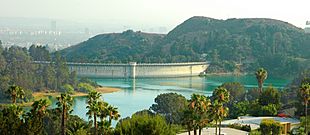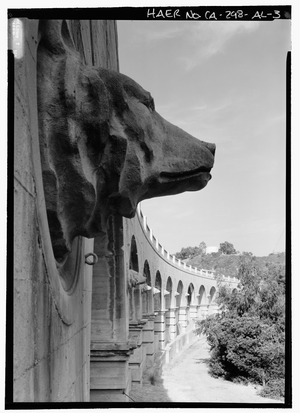Mulholland Dam facts for kids
Quick facts for kids Mulholland Dam |
|
|---|---|

A view of Hollywood Reservoir and the upstream side of Mulholland Dam
|
|
| Location | Hollywood Hills, Los Angeles, California |
| Coordinates | 34°07′5″N 118°19′52″W / 34.11806°N 118.33111°W |
| Construction began | 1923 |
| Opening date | 1924 |
| Owner(s) | Los Angeles Department of Water and Power |
| Dam and spillways | |
| Width (crest) | 16 feet (4.9 m) |
| Reservoir | |
| Creates | Hollywood Reservoir |
| Total capacity | 7,900 acre⋅ft (9,700,000 m3) |
| Maximum water depth | 183 ft (56 m) |
| Designated: | 1989 |
| Reference #: | 421 |
The Mulholland Dam is a large wall built to hold back water. It is located in the Hollywood Hills of Los Angeles, California. This important dam helps create the Hollywood Reservoir.
The reservoir can hold a lot of water, about 7,900 acre-feet. This water comes from different aqueducts and a creek called Weid Canyon. The deepest part of the reservoir is about 183 feet. The Los Angeles Department of Water and Power owns and manages the dam.
Contents
History of Mulholland Dam
How the Dam Got Its Name
The dam had a few names before it became the Mulholland Dam. First, it was called Weid Canyon Dam, then Hollywood Dam. It was finally named after William Mulholland. He was a very important person in Los Angeles.
William Mulholland was the chief engineer for the city's water system. He helped design and build the Los Angeles Aqueduct. This aqueduct brought much-needed water to the growing city. He also created many early dams and reservoirs.
Building the Dam
The area where the dam stands was first looked at for a reservoir in 1912. Ten years later, in 1922, plans for a stone dam began. Construction of the Mulholland Dam started in August 1923.
By December 1924, the dam was finished. It was the first curved concrete gravity dam built by the city's water department. A gravity dam uses its own weight to hold back water.
Safety Concerns and Changes
Another dam, the St. Francis Dam, was built with a similar design to Mulholland Dam. Sadly, in March 1928, the St. Francis Dam broke. This caused a terrible flood in the Santa Clarita River Valley, and many lives were lost.
After this disaster, William Mulholland ordered the Hollywood Reservoir to be lowered. This was a safety step and helped calm public fears. People worried if the Mulholland Dam might also be unsafe.
Because of the St. Francis Dam failure, California created new dam safety rules in 1929. The state now had the power to check all large dams. They could also supervise how dams were maintained and operated.
Making Mulholland Dam Safer
Soon after the St. Francis Dam broke, experts began to study the Mulholland Dam. Several groups of engineers and geologists looked at its design. They found that the dam needed improvements to be even safer. They worried about water pressure pushing up on the dam and how it would handle earthquakes.
To make the dam stronger, a big decision was made. The Hollywood Reservoir would always be kept at a lower water level. Today, it usually holds about 2,800 acre-feet of water. Also, a huge amount of earth was placed against the dam's outer side. This earth made the dam much stronger and also hid it from view.
This work was completed in 1933–1934. The city's water department then planted many trees and plants on the new earth. This helped the dam blend into the landscape. Today, studies show that Mulholland Dam meets all state safety guidelines.
See also
- California Water Wars
- List of dams and reservoirs in California
- Los Angeles Historic-Cultural Monuments in Hollywood


